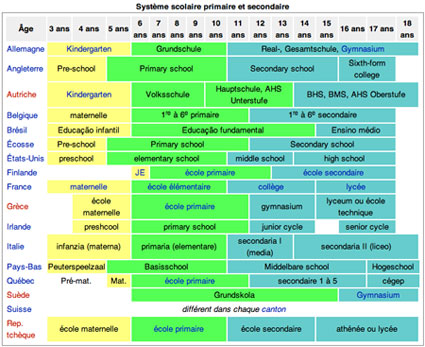 Se séparer, ce n’est pas quitter quelqu’un, c’est se quitter tous les deux. (Sacha Guitry)
Se séparer, ce n’est pas quitter quelqu’un, c’est se quitter tous les deux. (Sacha Guitry)
Je traîne aujourd’hui le mauvais souvenir de mon adolescence dilapidée dans un collège de garçons. Le sport m’a sauvé de l’enseignement aride des religieux, mais cela ne remplaçait pas tout à fait la diversité féminine. J’ai donc un préjugé favorable pour la mixité dans le débat sur la séparation des garçons et des filles dans les écoles. L’obsession pour les résultats scolaires nous distrait de l’interaction humaine. Ce qui n’empêche pas certains psychologues, comme Leonard Sax, de faire croisade pour un retour à la démarcation (New York Times : Teaching Boys and Girls Separately). Puisque la nostalgie est toujours d’actualité, je crois utile de mettre en ligne une compilation d’articles sur le sujet, même s’il ne s’est pas encore emparé du Québec.
• Revue française de pédagogie (2010) : La mixité scolaire, une thématique (encore) d’actualité? (PDF). Dans ce numéro consacré à la thématique de la mixité à l’école, nous sommes parties des textes émanant des conférenciers qui sont intervenus lors de cette conférence, ainsi que, dans une partie « contrepoints », des textes émanant de membres du jury. Toutes ces contributions témoignent de l’intérêt d’explorer les processus par lesquels le contexte mixte des classes est susceptible d’affecter la réus- site, l’orientation des élèves et plus globalement leur expérience scolaire quotidienne.
• Institut national de recherche pédagogique (2008) : Genre et éducation. La recherche a beaucoup attendu avant de s’intéresser aux inégalités sexuées. Mais désormais, on essaie de comprendre comment et pourquoi les garçons et les filles sont traités différemment. Et de nombreuses recherches scientifiques font état de l’impact du genre en éducation et revisitent l’éducation sous l’angle du genre.
• Sisyphe (2004) : La mixité scolaire n’a pas d’effet sur la motivation. Lorsqu’un effet lié à la non-mixité est observé, il est si faible qu’il ne met pas en cause la mixité scolaire, soutient Roch Chouinard, professeur au Département de psychopédagogie et d’andragogie. Le professeur a effectué l’une des seules études longitudinales jamais menées sur le sujet au Québec en prenant comme élément d’observation la motivation des filles.
• Le Soleil (2007) : Non-mixité à l’école: la classe des coureurs des bois (RTF). Les écoles publiques qui ont essayé les classes non mixtes ont pour la plupart cessé l’expérience. Parce que les circonstances avaient changé, mais aussi parce que les résultats n’étaient pas assez concluants.
————–
• Associated Press (2012) : Chicopee School Ends All-Girls Math Class. A Chicopee school is ending a three-year experiment with an all-girls math class after finding no evidence that it improved the students’ academic performance.
• Education Week (2012) : Scholars Say Pupils Gain Social Skills in Coed Classes. Generally, boys and girls become more polarized through their first years in school. Now, researchers have started to explore how to span that sex divide and are finding that more-equitable coed classrooms can have social and academic benefits for boys and girls alike.
• Carrefour éducation (2011) : Le programme « Garçons branchés » porte fruit. Après trois ans d’existence, le programme « Garçons branchés », de l’école secondaire Monseigneur-Richard, dans l’arrondissement Verdun, qui vise à prévenir le décrochage scolaire chez les garçons, connaît un grand succès. Sa recette = pas de filles + de la techno!
• EurekAlert! (2011) : History shows that all-boy classrooms might actually benefit girls. In recent years, the apparent decline in boys’ academic success rates has troubled politicians, researchers, and educators. It has been described as an educational crisis and a failure of the traditional school setting. The decline has spurred scores of potential solutions to the problem, including the adoption of same-sex classrooms as a way to better address boys’ educational needs. New research that will be presented at the 2011 Congress of the Humanities and Social Sciences in Fredericton, New Brunswick, indicates that the picture might not be so simple.
• Revue française de pédagogie (2010) : single-sex education: What does Research Tell us? (PDF). There has been considerable research and policy debate internationally about whether single-sex schooling yields academic and social advantages for girls and/or boys. This article outlines some of the findings from research on single-sex education conducted in English-speaking countries. In particular, it looks at research on the impact of single-sex schooling on academic achievement, subject take-up, personal and social development, and adult outcomes. In doing so, it attempts to provide a critical perspective on some of the key issues involved in comparing the two settings.
• Tel Aviv University (2008) : Keep Boys and Girls Together, TAU Research Suggests. Boys and girls may learn differently, but American parents should think twice before moving their children to sex-segregated schools. A new Tel Aviv University study has found that girls improve boys’ grades markedly at school.
• Globe and Mail (2007) : The boys are all right. Boasting smaller class sizes, lower dropout rates and a higher rate of graduates moving on to university compared with public schools, boys’ schools remain entrenched in tradition, emphasizing academic and athletic excellence.
• Globe and Mail (2007) : Where the boys aren’t. In contrast to some all-boys schools that have gone co-ed in the past, especially in their secondary component, all-girls private schools remain steadfastly popular, with no decline in sight.
• New York Times (2008) : Teaching Boys and Girls Separately. In part because of [...] a mix of cultural and technological forces — ranging from the growth of brain-scan research to the increased academic pressures on kindergarteners and a chronic achievement gap between richer and poorer students and between white and minority students — new single-sex public schools and classrooms are opening at an accelerating pace.
• The Orlando Sentinel (2006) : Separated for Success (RTF). The U.S. Department of Education and education reformers are willing to gamble that single-gender schools and classrooms will help solve what ails the nation’s 15,000 districts.
• The Star Bulletin (2006) : Boys will be boys: A case for single-gender education. Boys simply don’t learn the same way girls do, so why do we try to force them to?
• The Star-Telegram : Boys on the Side (RTF). A Dallas girls school – like other single-sex schools – explores different learning styles.
• The Christian Science Monitor (2004) : Separating the Sexes: A New Direction for Public Education?. In the past decade, single-sex schools have surged in popularity. Today, there are 25 same-sex public schools in the nation, almost all formed after 1996 [...]. Another 72 schools offer single-sex classes.
• Milwaukee Journal Sentinel (2006) : Single-sex classrooms, controversy grow. The growth in the number of single-sex educational offerings in recent years has been fueled by parents, politics and, most recently, growing publicity on the struggles of boys in classrooms.Single-sex education seems to make no difference to students’ achievements, a review of available research concludes.
• BBC (2006) : Single-sex schooling ‘irrelevant’. Single-sex education seems to make no difference to students’ achievements, a review of available research concludes.
• Washington Post (2006) : Schools May Offer More Single-Sex Classes Under New U.S. Regulations. New federal regulations [...] give school systems around the nation more flexibility in offering single-sex public education, even though the Department of Education concluded a year ago that there was not enough evidence to definitively evaluate single-sex classes.
• Daily Mail (2008) : Boys need to be taught separately from the age of five, says expert. Boys need to be taught separately from girls from the age of five to prevent them being damaged by the education system, an expert claimed yesterday. Dr Leonard Sax argues that boys are « turned off » by starting formal education too soon when they are expected to sit down and keep quiet in class.
• Newsweek (2005) : Boy Brains, Girl Brains: Are Separate Classrooms the Best Way to Teach Kids?. Jeff Gray is part of a new crop of educators with a radical idea–that boys and girls are so biologically different they need to be separated into single-sex classes and taught in different ways. In the last five years, brain researchers using sophisticated MRI and PET technology have gathered new information about the ways male and female brains develop and process information.
• Globe and Mail (2005) : Subtracting distraction from the equation (RTF). Perdita Rambihar was most impressed when her youngest daughter, a petite girl, choose to play soccer on a community team with teenaged boys who towered over her. « She wasn’t intimated. She didn’t back down. »
• Globe and Mail (2006) : Same-sex teaching boon for pupils, principal says (RTF). Grade 7 boys and girls appear to do better in elementary school if they’re separated by gender, an elementary school principal says.
• Globe and Mail (2006) : Boys and girls at B.C. school are in a class by themselves (RTF). In one classroom, Grade 7 students cover their desks with shaving cream and use their fingers to spell out words dictated by their teacher. Down the hallway, a group of enthusiastic pupils shoot up their hands to solve math problems. What’s unusual about these two classes is that the spellers are all boys and the budding mathematicians, bold and not afraid to speak up, are girls.
• Globe and Mail (2006) : An all-girls confidence builder (RTF). All-girls schools appeal to students and their parents, some educators say, because they arm female students with a can-do attitude, a sense of empowerment, and the freedom to focus on their studies without distractions.
Mise à jour, 25 septembre 2010 | Certains articles ont été ajoutés après la date originale de publication de ce billet.
Mise à jour, 15 juillet 2013 | À la demande d’Isabel, dans le commentaire daté du 15 juillet 2013, j’ai corrigé certains hyperliens rompus et ajouté quelques articles récents.
(Image thématique : Seperate, par Justin Barnhurst)
Par ricochet :
Différences de cerveau entre les sexes
L’éducation pénalise les garçons
Ségrégation garçons-filles à l’école : effet négligeable
Le sexe d’un enseignant affecte l’apprentissage
Différences entre garçons et filles (mes archives)
 Le sport de l’intelligence n’est rien sans l’intelligence du sport. (Paul Vialar)
Le sport de l’intelligence n’est rien sans l’intelligence du sport. (Paul Vialar)

















